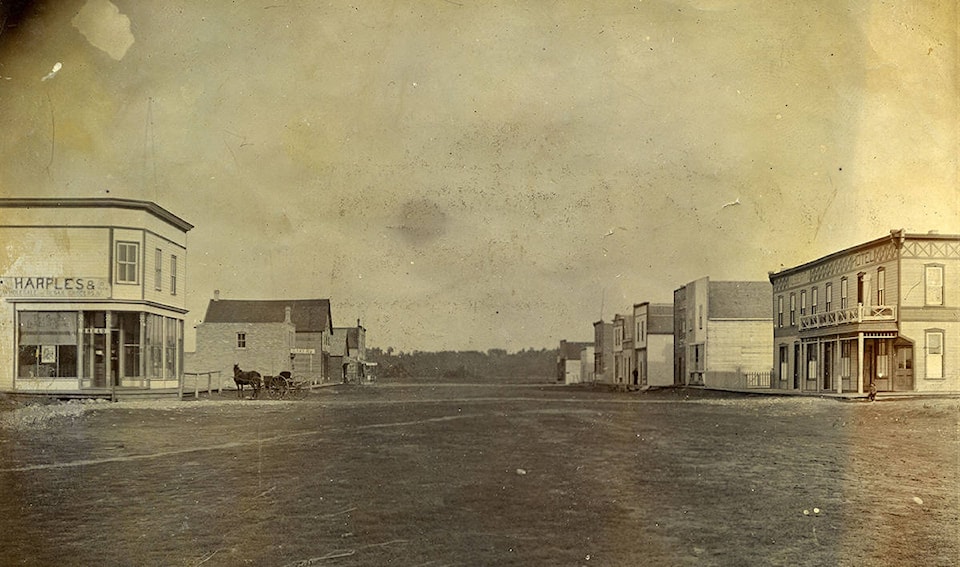On Wednesday, Oct. 16, the Red Deer and District Chamber of Commerce will be holding its annual Business of the Year Awards ceremony. The evening will also include a celebration of the 125 anniversary of the creation of the chamber (Red Deer Board of Trade) in 1894.
Red Deer, 125 years ago, was just a small hamlet. There were only twenty businesses and some three dozen frame houses clustered along the newly-built Calgary-Edmonton Railway. However, despite the very modest appearance of the community, there was a strong expectation that Red Deer was on the verge of a wonderful surge of growth and prosperity.
Not surprisingly, the energetic young businessmen and professionals decided to form a group to promote and direct the expected growth and development.
The organizational meeting of the Board of Trade was held on March 17, 1894 (St. Patrick’s Day) in the offices of the Red Deer Review, the community’s first newspaper. Ray Gaetz, a local merchant, was elected as the first president, while George W. Greene, a young lawyer, agreed to be the first secretary-treasurer.
The formal objects of the association were set as “the improvement of Red Deer and district commercially and municipally; the promotion of the district in its agricultural and natural resources; and in other such ways as may be beneficial to the district”. Member-ship was open to any man, 21 years or older, of good moral character, who paid an annual fee of $2.
The Board of Trade set as its first goal the establishment of a municipal government for the community. In June 1894, a successful petition was made to the government of the North West Territories to have Red Deer declared a village. The tax rate was set at 2 mills (i.e. $2 per $1000 of assessed property).
The second objective proved to be more difficult. An attempt was made to keep the The Review in business. The Board paid the paper’s freight charges and hand-delivered copies around the village. Despite these efforts, the paper folded into bankruptcy.
Good roads were a perennial concern. When the Territorial Government told the board that hundreds of dollars were being spent on the roads leading out of Red Deer, the board responded that the roads “leading into” Red Deer were “nearly impassable”.
In 1899, the traffic bridge across the Red Deer River was badly damaged in a flood. The board successfully lobbied the Territorial Government to build a new one. However, when the new bridge washed away in the next spring flood, the board unsuccessfully demanded a public enquiry into the poor engineering and/or shoddy workmanship.
By 1901, Red Deer’s population had jumped to 323. The Board of Trade assisted in the successful push to have Red Deer incorporated as a village. Ray Gaetz was elected as the first mayor.
Over the next dozen years, Red Deer boomed and the population rose to 2,800. In 1911, the Board of Trade was reorganized and reincorporated under federal statute. The Board of Trade increased its work on publicity and promotion. A full-time publicity commissioner was hired with the help of a hefty grant from the Town.
In order to further boost the community, the board produced new publicity pamphlets with a “photo” of what it predicted Red Deer would look like by the early 1920s. The image showed high rise office buildings in the downtown, street cars on Ross Street and steam boats on the Red Deer River.
The importance and influence of the Board of Trade was reflected in the fact that in 1912, the Board of Trade acquired large new offices in a major addition to the Town Hall. In 1913, Red Deer was formally incorporated as a city with Board of Trade support.
Unfortunately, the great boom broke shortly thereafter. Red Deer remained a small community of less than 3,000 for the next 35 years. The board underwent retrenchment and change as it met the challenges of an ongoing poor economy with little or no growth.
Nevertheless, the overall goal of the Board of Trade/Chamber of Commerce remained the promotion of commerce, industry, agriculture and a business-friendly environment. Most importantly, it worked hard to ensure that Red Deer was an attractive place to live and to establish/grow a business.
Red Deer historian Michael Dawe’s column appears every Wednesday.
